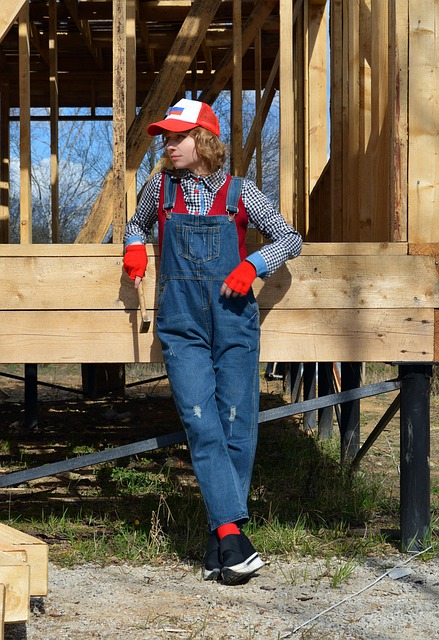Residential foundation cracks range from aesthetic to structural concerns, indicating issues like soil settlement or movement. Early detection through regular inspections is crucial for preventing minor problems from escalating into costly repairs. Traditional methods include visual and specialist tool inspections, while modern techniques like drone surveillance and thermal imaging enhance precision. Prompt action on crack detection is vital; even minor cracks can worsen over time. The repair process involves intensive inspection, identifying root causes, structural stabilization, crack filling, and moisture management. Preventative measures like regular assessments and addressing specific factors safeguard the foundation. Choosing an experienced contractor with a strong track record ensures effective, long-lasting repairs for residential foundation issues.
Foundation cracks can be a significant concern for homeowners, indicating potential structural issues. This article delves into the world of residential foundation repair, offering a comprehensive guide on crack detection and resolution. From understanding common types and causes to exploring modern technologies like thermal imaging and radar, we cover traditional methods and preventative measures. Learn about evaluating crack severity, the repair process, and choosing the right contractor for reliable solutions in Residential Foundation Repair.
Understanding Foundation Cracks: Common Types and Causes

Foundation cracks, a common concern in many homes, can range from minor aesthetics to significant structural issues. Understanding these cracks and their causes is essential for homeowners looking into Residential Foundation Repair. There are several types, each with distinct patterns and indications of underlying problems. Hairline cracks, typically appearing as thin lines, often result from settling and may not always signal a severe issue. In contrast, large, vertical cracks suggest more substantial structural problems, potentially indicating soil movement or poor foundation design.
Causes vary widely, including settlement, expansion, and contraction due to temperature changes, uneven soil conditions, poor construction practices, and tree roots exerting pressure on the foundation. Identifying the specific type of crack and its cause is crucial for effective repair strategies. Homeowners should remember that early detection through regular inspection can prevent minor issues from escalating into costly and complex residential foundation repair situations.
The Impact of Foundation Cracks on Residential Properties

Foundation cracks in residential properties can have significant impacts on the structural integrity and overall value of homes. These cracks, often a result of settlement or movement of the soil beneath, may seem insignificant at first glance but can signal deeper issues within the foundation. Over time, if left unaddressed, they can lead to more severe structural damage, affecting the stability of the entire building.
Residential foundation repair is a crucial step in mitigating these effects. Prompt action involves assessing the extent of the cracks and implementing suitable solutions like underpinning, piering, or wall anchors to stabilize the foundation. Such measures not only prevent further deterioration but also ensure the long-term durability and safety of the property, ensuring peace of mind for homeowners.
Traditional Methods for Crack Detection: Visual Inspection and Specialist Tools

Traditional methods for crack detection in residential foundation repair often rely on visual inspection and the use of specialist tools. During a visual inspection, professionals carefully examine the foundation walls, floors, and any visible areas for signs of cracks. These cracks can range from hairline fissures to larger breaks that may indicate more severe structural damage. It’s crucial to assess the crack’s width, length, and pattern, as these factors help in determining the severity and potential causes.
Specialist tools, such as depth gauges and crack measuring devices, are employed to quantify the extent of cracks. These tools provide precise measurements, enabling experts to identify cracks that may be invisible to the naked eye. Additionally, non-destructive testing methods, like ultrasound or ground-penetrating radar (GPR), can offer detailed images of underground structures, helping in identifying hidden foundation cracks. Such traditional approaches form the backbone of residential foundation repair practices.
Modern Techniques: Using Technology for Efficient Crack Identification

In today’s digital era, modern techniques for crack detection in residential foundation repair have revolutionized the industry. Advanced technologies such as drone surveillance and thermal imaging cameras are being employed to identify even the slightest cracks, which might be imperceptible to the naked eye. Drones equipped with high-resolution cameras can inspect hard-to-reach areas, providing a comprehensive bird’s-eye view of the foundation. Thermal imaging, on the other hand, detects temperature variations, helping to uncover hidden cracks that may indicate structural instability.
These innovative methods not only enhance efficiency but also ensure more precise and timely intervention. By utilizing such technology, homeowners can benefit from early crack detection, preventing minor issues from escalating into costly and extensive repairs. This proactive approach to residential foundation repair is a game-changer, ensuring the longevity and integrity of homes.
Non-Invasive Methods: Thermal Imaging and Radar Technology

Non-invasive methods have revolutionized residential foundation repair by offering efficient and effective ways to detect cracks without causing further damage. Thermal imaging is one such technology that utilizes heat variations to create detailed images of the foundation. By identifying areas with differing temperatures, professionals can pinpoint precisely where structural weaknesses or cracks exist. This method is particularly useful for early detection as it can uncover subtle issues that might otherwise go unnoticed during visual inspections.
Radar technology another powerful tool in the arsenal for foundation crack detection. It sends radio waves into the ground and measures the time it takes for them to bounce back, creating a profile of the foundation’s integrity. This non-destructive approach allows contractors to assess the depth and width of cracks without disturbing the surrounding area. By combining thermal imaging and radar technology, Residential Foundation Repair specialists can offer comprehensive assessments, ensuring that any detected issues are accurately diagnosed and addressed promptly.
When to Act: Evaluating the Severity and Need for Repair

When it comes to foundation crack detection, acting promptly is crucial for effective residential foundation repair. Homeowners should not ignore cracks in their foundations, even if they appear minor. Over time, even small cracks can worsen and lead to more significant structural damage, impacting the stability of the entire structure. Regular inspections are key to early detection; observing cracks during periodic assessments allows for a better understanding of their progression.
Evaluating the severity involves considering both the size and pattern of cracks. Wider or vertical cracks, especially those that extend through multiple levels, warrant immediate attention. Uneven floors, distorted doors, or windows that stick may indicate underlying foundation issues. If cracks are accompanied by settling or shifting in the structure, it becomes evident that professional intervention is necessary. Prompt action ensures minimal repair costs and prevents potential hazards caused by unstable foundations.
The Process of Foundation Repair: Steps from Assessment to Restoration

The process of repairing a residential foundation involves several crucial steps, ensuring a thorough assessment and effective restoration. It begins with an extensive inspection to identify the scope of damage, including cracks, settlement issues, or signs of water intrusion. Skilled professionals use advanced tools and techniques for this initial evaluation, pinpointing the root causes behind the foundation problems. Once identified, a plan is devised, tailored to the specific needs of the property.
The actual repair process entails several stages. It often starts with addressing structural damage through various methods like underpinning, where additional support is added to stabilize the foundation. Cracks are then repaired using specialized epoxies or hydraulic cement, ensuring they don’t reoccur. For water-related issues, drainage solutions may be implemented to divert moisture away from the foundation, preventing further damage. Throughout, attention is paid to maintaining the structural integrity and aesthetic appeal of the property, resulting in a solid, stable residential foundation.
Preventative Measures: Strategies to Fortify Your Home's Foundation

Preventative measures play a crucial role in safeguarding your home’s foundation from cracks and other structural damage. Regular inspection is the first line of defense; scheduling professional assessments at least once a year can help identify potential issues early on. This proactive approach to residential foundation repair allows for quick interventions, minimizing the risks associated with extensive repairs.
Beyond inspections, fortifying your home’s foundation involves addressing specific factors contributing to instability. Proper drainage around the house is essential, ensuring water doesn’t pool near the foundation walls. Soil conditions also play a significant role; using anchors or bracing to stabilize shifting soil can prevent foundation cracks from developing. Additionally, maintaining proper humidity levels indoors and preventing excessive moisture ingress can protect against settlement issues, thereby safeguarding your home’s structural integrity.
Choosing the Right Contractor: Ensuring Expertise in Residential Foundation Repair

When it comes to residential foundation repair, choosing the right contractor is paramount. Look for professionals who specialize in this specific area and have extensive experience handling various types of foundation cracks. Expertise matters; a well-versed contractor can accurately diagnose the root cause of the issue, ensuring long-lasting repairs.
Inquire about their track record, previous projects, and client testimonials to gauge their proficiency. Reputable contractors will be insured and licensed, offering peace of mind during the repair process. Their knowledge not only guarantees effective solutions but also prevents further damage, saving you potential costs in the long term for your residential foundation repair needs.
